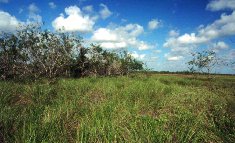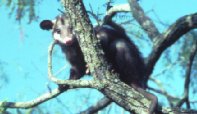 |
 | |
  | |
|
|
|
|
Palo Alto Battlefield National Historic Site
Nature & Science
|
|
|
|
|
|
 |
 |
| A prairie view |
 |
Palo Alto Battlefield National Historic Site was created to recognize an important historical event, but it is also notable for its natural features. Drawn around an expanse of more than 3,400 acres of undeveloped land, the park boundaries contain an abundance of plant and animal life, including many species that are unique to the U.S-Mexico border region.
The defining feature of Palo Alto is the broad coastal prairie-scene to the 1846 battle between the United States and Mexico. This coastal plain is carpeted with clumps of razor-sharp cord grass and other low-lying grasses and flowers. The field stretches eastward for miles toward the Gulf of Mexico, interrupted only by scattered trees, yuccas, and prickly-pear cactus.
|
 |
| Opossum |
 |
The site, however, also includes other, much different areas. To the north, south, and west, the open prairie gives way to dense thickets of mesquite, acacia, and thorny undergrowth that crown low rises and are believe to have inspired the name Palo Alto-or tall trees. The park is also criss-crossed by a series of shallow ravines, known as resacas. The resacas once formed the bed of the ever-shifting Rio Grande. Although they remain dry for much of the year, occasional heavy rains create small pools in these former river channels and spurs the growth of reedy plants that thrive in marshy areas.
This assortment of habitats also supports a variety of animal life. Coyotes, jackrabbits, and bobcats roam the open plain. Javelina, opossums, tortoises and many otheranimals find refuge in the cover of brush. Rattlesnakes, scorpions, and fiddler crabs can be found in burrows under the ground while dozens of different kinds of birds, including raptors and tropical species can be spotted on their perches in tree branches.
|
 |
| Bird on a yucca |
 |
The abundance of wildlife makes the Palo Alto Battlefield an attractive stopping point for nature lovers. Bird watching has become a particularly popular pastime at the park, with visitors taking the opportunity to view birds of prey like the Harris Hawk, Aplomado Falcon as well as colorful species like the Roseate Spoonbill. As the park continues to make more of the battlefield accessible to the public, it seems certain that the site will lure as many bird watchers and natural enthusiasts in number that rival those who visit for the historical importance of the battlefield.
This situation creates an interesting dilemma in the management of the park. As a unit of the National Park Service-one of the nation's premier conservation agencies-Palo Alto is dedicated to appropriately documenting, protecting, and managing the natural resources on the site. As a National Historic Site, however, the park must place an emphasis on the historical importance of the site. Any activities to manage or restore habitat and wildlife must be planned carefully, to ensure that well-meaning projects do not have a negative effect on the historical and archeological features of the battlefield.
|
 |
| Battlefield vegetation |
 |
Fortunately, efforts to care for the cultural and natural resources of the battlefield usually complement each other. Plans to preserve the battlefield generally support the preservation of plants and animals that have lived on the site since the time of the U.S.-Mexican War. Likewise, projects to restore the landscape to its appearance at the time of the 1846 clash commonly encourage the park to restore native habitat and species.
These efforts to conserve both the natural and historical landscapes of the site will ultimately benefit park visitors. History enthusiasts who visit the park will have an opportunity to view the terrain and vegetation that influenced the course of the 1846 battle. Nature enthusiasts will have an opportunity to view plants and animals that drew the attention of soldiers more than 150 years ago. All visitors will find Palo Alto to be a place of stark beauty--a living monument to the men who fought for their countries so many years ago.
|
|  |  |

|
 |
|
|
|
|
|
 |
|
Did You Know?
Jean Luis Berlandier served as an Engineer with the Mexican army on the Rio Grande, but also had a career as a botanist. Berlandier participated in several explorations of Texas in the 1820s and 1830s and compiled extensive documentation of the plants and wildlife of the region.
more...
|
|
|
|
Last Updated: September 22, 2006 at 15:31 EST |






